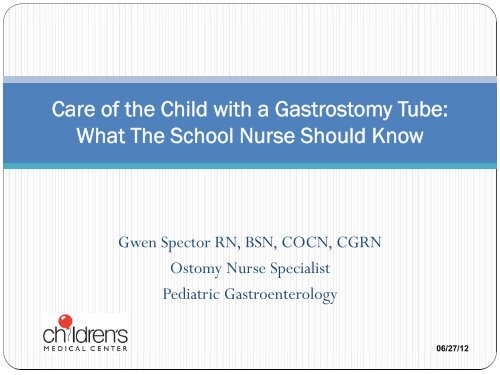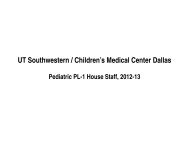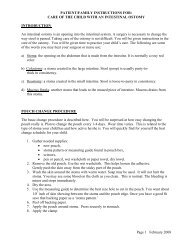Care of the Child with a Gastrostomy Tube
Care of the Child with a Gastrostomy Tube
Care of the Child with a Gastrostomy Tube
Create successful ePaper yourself
Turn your PDF publications into a flip-book with our unique Google optimized e-Paper software.
<strong>Care</strong> <strong>of</strong> <strong>the</strong> <strong>Child</strong> <strong>with</strong> a <strong>Gastrostomy</strong> <strong>Tube</strong>:<br />
What The School Nurse Should Know<br />
Gwen Spector RN, BSN, COCN, CGRN<br />
Ostomy Nurse Specialist<br />
Pediatric Gastroenterology<br />
06/27/12
Today’s Lesson:<br />
1. <strong>Gastrostomy</strong> <strong>Tube</strong>s<br />
2. Daily <strong>Care</strong> and Use <strong>of</strong> <strong>the</strong> G-tube<br />
3. Common Problems<br />
4. Resources<br />
5. Skills
The Why, When, Where, How, &<br />
What <strong>of</strong> <strong>Gastrostomy</strong> <strong>Tube</strong>s
Indications for <strong>Gastrostomy</strong><br />
• A gastrostomy device is placed for <strong>the</strong> purpose <strong>of</strong><br />
feeding, administering medications and/or<br />
decompressing <strong>the</strong> stomach.<br />
• Feedings can be given directly into <strong>the</strong> stomach or small<br />
intestine.<br />
• The gastrostomy device may be used as a supplement<br />
to oral feeds or <strong>the</strong> patient may be solely fed this way<br />
• A gastrostomy is generally placed when enteral feedings<br />
are necessary for longer than 6-12 weeks time. It may be<br />
needed for <strong>the</strong> rest <strong>of</strong> <strong>the</strong> patient’s life or for a shorter<br />
period depending on <strong>the</strong> patient’s circumstances.<br />
6/29/2012
Indications for <strong>Gastrostomy</strong><br />
Aspiration/swallowing problems<br />
Failure to thrive/poor growth-sometimes ? cause<br />
High caloric needs-like Cystic Fibrosis<br />
Minimal or no oral intake, poor suck/nippling<br />
Medically necessary medications and/or fluids-for<br />
patients w/ seizures/diabetes insipidus, etc.<br />
Need for specialized diets<br />
Trauma/anomaly <strong>of</strong> <strong>the</strong> mouth or esophagus
Intro to <strong>Gastrostomy</strong><br />
A gastrostomy is a surgically<br />
created opening in <strong>the</strong><br />
stomach.<br />
This opening is also referred<br />
to as <strong>the</strong> stoma.<br />
The gastrostomy tube enters<br />
<strong>the</strong> stomach through this<br />
stoma and tract.<br />
The tract is <strong>the</strong> channel-like<br />
formation between <strong>the</strong><br />
stomach and <strong>the</strong> skin where<br />
<strong>the</strong> G-tube/button is located.
The Method <strong>of</strong> Placement:<br />
The gastrostomy is created and <strong>the</strong> gastrostomy tube<br />
placed during one <strong>of</strong> <strong>the</strong>se methods:<br />
1. Surgical<br />
a. Open procedure<br />
b. Laparoscopic<br />
2. Endoscopic<br />
3. Radiological
Primary vs Secondary Devices:<br />
Primary devices:<br />
Placed during <strong>the</strong> original<br />
gastrostomy surgery<br />
The tract is new<br />
Secondary devices:<br />
Placed after conversion <strong>of</strong><br />
<strong>the</strong> primary tube<br />
The goal <strong>of</strong> <strong>the</strong> surgery<br />
is for <strong>the</strong> stomach to<br />
adhere to <strong>the</strong> abdominal<br />
wall, creating a tract<br />
where <strong>the</strong> tubes will be<br />
placed.<br />
The tract takes time to<br />
mature*:<br />
6-8 weeks for tubes/ buttons in<br />
which <strong>the</strong> stomach was sutured<br />
to <strong>the</strong> abdominal wall<br />
12 weeks for tubes/buttons not<br />
sutured like <strong>the</strong> PEG tube<br />
* This is an approximate time
<strong>Gastrostomy</strong> Primary <strong>Tube</strong>s<br />
Surgical tube<br />
Placed by a surgeon during open<br />
surgery<br />
The stomach is sutured to <strong>the</strong><br />
abdominal wall<br />
Often done w/ Nissen<br />
Fundoplication<br />
<strong>Tube</strong> needs stabilization<br />
Changed to <strong>the</strong> button in<br />
6-8 weeks<br />
Pezzar tube w/ DTAD 1<br />
1 Drainage <strong>Tube</strong> Attachment Device<br />
2 Percutaneous Endoscopic <strong>Gastrostomy</strong> <strong>Tube</strong>s<br />
PEG tube<br />
Placed generally by<br />
Gastroenterologist<br />
(sometimes <strong>with</strong> a<br />
surgeon)<br />
Has an external bolster<br />
Stomach not sutured<br />
Changed to a G-button in<br />
3-6 months<br />
• Primary G-button<br />
• Laparoscopic or endoscopic<br />
placement<br />
• Limited manipulation for<br />
<strong>the</strong> 1 st 2 weeks<br />
PEG tube
<strong>Gastrostomy</strong> Button<br />
AKA: low pr<strong>of</strong>ile tube, skin level device<br />
2 main types:<br />
Balloon<br />
Non-balloon<br />
Placement:<br />
Primary-placed <strong>with</strong> initial gastrostomy surgery<br />
Laparoscopic<br />
PEG (One step)<br />
Secondary to a longer G-tube after <strong>the</strong> tract has matured 1<br />
4-6 weeks after open surgical tube placement<br />
3 -6 months after PEG tube placement<br />
Needs feeding extension to administer feedings/medications<br />
1 <strong>the</strong>se are approximate times
Comparison <strong>of</strong> Types <strong>of</strong> G-Buttons:<br />
Balloon<br />
Non-balloon<br />
Advantages Easily replaced @ home<br />
Comes in multiple sizes<br />
Disadvantages Balloon breaks, needs more frequent<br />
replacement<br />
Easier to dislodge<br />
Lasts longer (sometimes up to several years)<br />
No balloon to break<br />
Not as likely to be accidentally dislodged<br />
Has to be changed by provider or nurse w/<br />
advanced training<br />
Not available in as many sizes as balloon type<br />
May need sedation to place<br />
Physician preference and availability <strong>of</strong> buttons may direct what is placed<br />
Some devices need size specific extensions and<br />
separate decompression extension (BARD<br />
button)
Balloon-Type G-Buttons<br />
Brands:<br />
Mic-key®<br />
Mini®, Mini ONE balloon®<br />
Nutriport<br />
Multiple Sizes: Mini ONE balloon®<br />
Fr: 12,14,16,18,20,24<br />
Cm: 0.8 – 5.0 cm<br />
Balloon<br />
5 mL on most buttons (4 mL for neonates or 12 Fr .<br />
buttons)*<br />
over inflation can obstruct pylorus or cause<br />
gastric erosions<br />
Use sterile /distilled water and preferably 6-10 mL slip<br />
tip syringe<br />
Extensions are not size specific <strong>with</strong>in each<br />
brand.<br />
*Read manufacturer guidelines<br />
Internal lock system<br />
(‘key”)<br />
Mic-key®<br />
Mini ONE balloon G-button
Non-balloon Type G-Button<br />
Has a silicone mushroom or baskettype<br />
tip inside to keep <strong>the</strong> G-button<br />
from coming out<br />
Placed <strong>with</strong> an obturator 1 or special<br />
insertion device to stretch out <strong>the</strong><br />
internal bolster<br />
Brands:<br />
BARD ® or Microvasive ®,<br />
Mini ONE ® non-balloon<br />
Entristar ®<br />
Sizes:<br />
Varies, more limited than<br />
balloon-type<br />
• BARD/Microvasive ® buttons have<br />
separate decompression tubes, sizespecific<br />
extensions<br />
BARD ®<br />
1
G-J tubes/buttons<br />
The (G-J) tube is actually 2 tubes in<br />
one and is placed through a<br />
gastrostomy tract.<br />
• The jejunal portion is advanced into<br />
<strong>the</strong> intestine to bypass <strong>the</strong> stomach<br />
for feedings. (under fluoro)<br />
• The feedings go through <strong>the</strong> jejunal<br />
port while <strong>the</strong> medications are to be<br />
administered through <strong>the</strong><br />
gastric port<br />
• Continuous feedings are given for<br />
usually 18-24 hours. Bolus feedings<br />
are not usually given in order to<br />
prevent dumping syndrome.<br />
3<br />
1<br />
3<br />
There are 3 ports:<br />
1. Jejunal (intestine)<br />
2. Gastric (stomach)<br />
3. Balloon<br />
2<br />
1<br />
2<br />
2<br />
1<br />
3
Special Uses<br />
Sometimes a button is placed in <strong>the</strong> cecum in <strong>the</strong> first part <strong>of</strong><br />
<strong>the</strong> colon for <strong>the</strong> administration <strong>of</strong> laxatives in a child <strong>with</strong><br />
bowel problems.<br />
This is called a cecostomy button. The same feeding buttons<br />
are used as are used <strong>with</strong> gastric feedings.<br />
The button will usually be located in <strong>the</strong> RLQ.<br />
<strong>Care</strong> is similar to <strong>the</strong> gastrostomy button.
Anatomy <strong>of</strong> a G-tube/button<br />
1. External bolster prevents tube/button<br />
from migrating into stoma<br />
6<br />
5 4<br />
1<br />
2<br />
2<br />
3<br />
1 5<br />
2. Internal bolster/retention balloon secures<br />
device internally<br />
3. Balloon valve allows access to<br />
inflate/deflate <strong>the</strong> balloon<br />
4. Anti-reflux valve <strong>with</strong>in <strong>the</strong> feeding port <strong>of</strong><br />
button prevents reflux <strong>of</strong> formula<br />
5. Flap/cap over access port<br />
6. Feeding adaptor<br />
4<br />
1<br />
2
Daily <strong>Care</strong> and Use <strong>of</strong> <strong>the</strong> G-tube
Daily <strong>Care</strong><br />
Routine <strong>Care</strong>:<br />
Assess <strong>the</strong> site for<br />
abnormalities<br />
Stabilize/secure <strong>the</strong> tube<br />
Clean <strong>the</strong> skin around <strong>the</strong> tube<br />
<strong>with</strong> mild soap & water if<br />
needed<br />
Apply topical treatment(s) if<br />
ordered<br />
Change dressings when soiled<br />
(if applicable)<br />
Reusable G-tube pads<br />
Post-op Period:<br />
Sutures may be present. Some<br />
<strong>of</strong> <strong>the</strong>se are dissolvable and<br />
some will need to be removed<br />
in approximately 1 week by a<br />
HCP.<br />
There may be a mid-line<br />
incision and steri-strips in<br />
place. Let <strong>the</strong> steri-strips fall<br />
<strong>of</strong>f on <strong>the</strong>ir own.<br />
Primary G-buttons have<br />
specific care instructions:<br />
Minimal manipulation for <strong>the</strong><br />
first 2 weeks.
Nursing Assessment<br />
Assess <strong>the</strong> gastrostomy site<br />
Is <strong>the</strong>re redness? Is it streaky, bumpy or uniform?<br />
Is <strong>the</strong>re swelling/induration?<br />
Is <strong>the</strong>re drainage? How much? What color? Does it happen more<br />
at certain times?<br />
Is <strong>the</strong>re an odor?<br />
Is <strong>the</strong>re pain? With touching, <strong>with</strong> feeds, all <strong>the</strong> time or<br />
intermittent?<br />
Does <strong>the</strong> gastrostomy device fit well? Not too loose or too tight.<br />
Assess <strong>the</strong> abdomen<br />
Is <strong>the</strong>re distension and/or firmness?<br />
Is <strong>the</strong>re pain?
Stabilizing <strong>the</strong> G-tube<br />
Extremely important!<br />
Prevents migration <strong>of</strong> tube<br />
Prevents rocking motion*<br />
Goal: keep tube from being pulled and<br />
maintain a 90 degree angle<br />
Don’t tape down too tight, no tension*<br />
Some tubes have a stabilization device already<br />
Some tubes need an external stabilizer<br />
i.e. drainage tube attachment device,<br />
sausage roll, baby nipple<br />
Hollister® drainage tube<br />
attachment device<br />
baby nipple &<br />
hydrocolloid dressing<br />
Sausage roll<br />
* Dressing <strong>the</strong> tube flat against <strong>the</strong> abdomen<br />
causes enlargement <strong>of</strong> <strong>the</strong> stoma
Protecting <strong>the</strong> <strong>Gastrostomy</strong> <strong>Tube</strong>/button<br />
The G-tube/button may need to<br />
be protected if <strong>the</strong> patient tries to<br />
pull on it or is very active and<br />
bumps it. It can be challenging to<br />
find <strong>the</strong> method that works for<br />
that patient. Some things that<br />
work are:<br />
Stretchy gauze/netting<br />
ACE bandage<br />
Abdominal binder<br />
Clothing like Onsies, overalls<br />
Tape/Coban
Feeding through <strong>the</strong> G-tube/button<br />
Feedings are given continuous and/or<br />
bolus per pump, syringe or gravity bag.<br />
The patient should be on <strong>the</strong> right side<br />
<strong>with</strong> <strong>the</strong> HOB elevated 30 0 during and<br />
30-60 minutes after feedings.<br />
Bolus/syringe feedings should not be<br />
given too fast. The more elevated <strong>the</strong><br />
syringe is –<strong>the</strong> faster <strong>the</strong> formula will run<br />
in.<br />
Always stabilize <strong>the</strong> G-button <strong>with</strong> your<br />
fingers when attaching extensions<br />
Syringe feeds should be to gravity, do<br />
NOT force-ok to gently push.<br />
Signs <strong>of</strong> formula intolerance include<br />
abdominal distension,cramping, diarrhea<br />
and/or vomiting. Some children have a<br />
Nissen and can’t vomit. You may need to<br />
stop feedings or slow <strong>the</strong> rate down.
Flushing <strong>Gastrostomy</strong> Devices<br />
Flush <strong>the</strong> gastrostomy devices <strong>with</strong><br />
<strong>the</strong> appropriate amount <strong>of</strong> water<br />
before and after feedings and<br />
medications:<br />
10 mL unless <strong>the</strong> patient is fluid<br />
restricted <strong>the</strong>n 3 – 5 mL is<br />
appropriate unless o<strong>the</strong>rwise<br />
ordered per <strong>the</strong> provider.<br />
Jejunal tubes require a greater<br />
amount <strong>of</strong> flush in order to prevent<br />
<strong>the</strong> tube from clogging 1 .<br />
Any gastrostomy device should<br />
also be flushed every 6 hours<br />
when receiving continuous<br />
feedings.<br />
Your <strong>Child</strong>’s Amount <strong>of</strong><br />
Weight flush<br />
< 20 pounds 10 ml<br />
20-75 pounds 15 ml<br />
>75 pounds 20 ml<br />
1 Flush for jejunal tubes
Giving Medication through <strong>the</strong> G-tube/button<br />
Don’t crush pills that are time<br />
released<br />
Do not give medications that<br />
dissolve under <strong>the</strong> tongue or are<br />
sustained release through <strong>the</strong><br />
tube.<br />
Don’t mix medications <strong>with</strong><br />
formula or in formula bag<br />
unless ordered by <strong>the</strong> provider<br />
Give medications separately<br />
from each o<strong>the</strong>r to avoid drug<br />
interactions.<br />
Phenytoin should be given 1<br />
hour before or 2 hours after<br />
enteral feeding.<br />
It is preferred that medications that<br />
are given through a G-button<br />
should be given through <strong>the</strong><br />
medication port <strong>of</strong> <strong>the</strong> feeding<br />
extension instead <strong>of</strong> directly into<br />
<strong>the</strong> button because <strong>the</strong> valve can be<br />
damaged.<br />
Give medications through <strong>the</strong><br />
correct port – be careful not give<br />
medications through <strong>the</strong> balloon<br />
port.<br />
Medication port <strong>of</strong> Mic-key extension
Venting <strong>the</strong> <strong>Tube</strong><br />
You may need to vent <strong>the</strong> patient’s tube to remove excess<br />
air or fluid. You can do this a few different ways:<br />
Use a ca<strong>the</strong>ter-tip syringe and aspirate <strong>the</strong> excess air<br />
from stomach or hold <strong>the</strong> syringe above <strong>the</strong> stoma<br />
Some non-balloon G-buttons have specific extensions<br />
for decompression (size specific), o<strong>the</strong>rs like <strong>the</strong><br />
balloon-type G-buttons use <strong>the</strong> regular feeding<br />
extension to vent.<br />
Farrell Valve ® Gastric Pressure Relief Device is<br />
recommended to use <strong>with</strong> continuous feeds.<br />
It’s designed to help patients who suffer from poor<br />
gastric motility, pain and bloating.<br />
New bag every 24 hours<br />
www.corpakmedsystems.com/Product_Main/enteral_<br />
main.html#Farrell<br />
Farrell Valve
Cleaning <strong>the</strong> Equipment<br />
Feeding extensions:<br />
Wash <strong>with</strong> warm soapy water<br />
or half white vinegar/half<br />
water.<br />
Flush through <strong>with</strong> warm<br />
water<br />
Hang to dry or flush air<br />
through.<br />
May reuse for 2 weeks*<br />
Rinse feeding bags/ syringes<br />
after each use<br />
*per manufacturer’s guidelines<br />
Mic-key/Mini ONE extension set<br />
Decompression<br />
extension<br />
Pump extension<br />
Bolus extension<br />
Bolus extension<br />
BARD ® or Microvasive ®,
Common Problems You May See<br />
1. Stoma<br />
2. Skin Problems<br />
3. <strong>Tube</strong> Problems
Stoma: Leakage<br />
All gastrostomies leak some<br />
There are multiple causes<br />
<strong>of</strong> leakage including:<br />
Any increase in intraabdominal<br />
pressure:<br />
constipation, coughing,<br />
heavy breathing,<br />
ventilated kids, crying,<br />
vomiting, change in<br />
weight or abdominal girth<br />
Balloon has deflated<br />
Incorrect size, improper<br />
stabilization<br />
Underlying disorder like slow<br />
motility<br />
<strong>Tube</strong> displacement<br />
Poor wound healing<br />
Body structure: scoliosis<br />
Positioning<br />
Spasticity<br />
Inability to decompress<br />
stomach<br />
Feeding intolerance<br />
Recent illness/new medications
Stoma: Leakage<br />
Treatment:<br />
Treat <strong>the</strong> underlying cause<br />
Change to correct size and/or new button<br />
Add more water to <strong>the</strong> balloon<br />
Medication to suppress <strong>the</strong> acid in <strong>the</strong> stomach per provider<br />
Protect skin<br />
Barrier Products: Powder, Creams<br />
Dressings: gauze, foam<br />
Pouch/attach to drainage bag if leakage extreme<br />
Change rate/route <strong>of</strong> feeds
Skin: Irritant Dermatitis<br />
Cause:<br />
Primarily from leakage <strong>of</strong><br />
gastric contents 1<br />
Can also be from harsh<br />
cleansers, antibacterial &<br />
o<strong>the</strong>r topical medications,<br />
external bolster too tight<br />
Sometimes skin conditions<br />
such as eczema can mimic<br />
this •Treatment:<br />
•Correct <strong>the</strong> cause<br />
1<br />
•Barrier products: creams, powders<br />
to protect and heal <strong>the</strong> skin<br />
•Oral/topical medications per<br />
provider to reduce acid<br />
•Absorptive dressings<br />
1
Skin Protection: Building a Barrier<br />
Purpose:<br />
Keeps good moisture in and bad moisture out<br />
Protects <strong>the</strong> skin from caustic fluids<br />
Technique as important as <strong>the</strong> products are<br />
Products:<br />
zinc oxide, petrolatum , skin prep, barrier<br />
powder<br />
Technique:<br />
Put medications on first<br />
If using powder apply before barrier creams and<br />
sprays<br />
Skin prep/film helps seal in powder and provide<br />
a light barrier<br />
Apply creams thick like icing<br />
Layer if needed<br />
Don’t wipe completely <strong>of</strong>f each time, blot and<br />
reapply<br />
1<br />
2<br />
3<br />
Barrier Products<br />
1. powder<br />
2. cream<br />
3. prep
Skin: Hypergranulation Tissue<br />
1<br />
One <strong>of</strong> <strong>the</strong> most common problems<br />
seen-<strong>the</strong> body is trying to heal<br />
Extra growth <strong>of</strong> tissue; pink-red.<br />
Sometimes beefy 1 looking.<br />
Yellow, “snotty” and/or brown<br />
drainage<br />
Sometimes friable – may bleed<br />
May be painful<br />
Often mistaken for an infection<br />
2<br />
Cause: incorrect stabilization, tube<br />
moving around in <strong>the</strong> stoma a lot,<br />
excessive moisture, Peroxide use,<br />
Dilantin, occlusive dressings<br />
Treatment:<br />
silver nitrate application per<br />
provider/trained nurse<br />
Tissue will turn gray/black and slough<br />
<strong>of</strong>f 2 . May discolor clothing and skin.<br />
Steroid creams: Triamcinolone<br />
Stabilize <strong>the</strong> tube, change size <strong>of</strong> button,<br />
don’t leave extensions on when not is use, if<br />
extensions are needed for long periodstape<br />
down to limit movement in <strong>the</strong> stoma.<br />
Barrier powder to control moisture<br />
Foam dressings
Skin: Bacterial Infection<br />
Appearance:<br />
Red streaking, spreading<br />
ery<strong>the</strong>ma<br />
Swelling around <strong>the</strong> site<br />
Abnormal bump<br />
O<strong>the</strong>r symptoms:<br />
Increased tenderness<br />
May or may not have fever, odor<br />
or green/purulent drainage Cause:<br />
MRSA common source<br />
Poor hygiene<br />
Tight fit <strong>of</strong> device/tension on<br />
<strong>the</strong> stoma<br />
Treatment:<br />
Clean w/ sterile water or saline<br />
2-3x/d<br />
Antibiotics per provider<br />
Silver dressings<br />
Cellulitis
Skin: Fungal Infection<br />
Appearance:<br />
Red papular rash, <strong>of</strong>ten has satellite lesions.<br />
Causes:<br />
Trapped moisture<br />
Hot, humid environment<br />
G-tube located deep in a skin fold<br />
chronic moisture, immuno-suppression,<br />
cortico-steroids and diabetes<br />
TX:<br />
Keep area clean and dry<br />
Antifungal medication as prescribed per<br />
provider
<strong>Tube</strong>: malfunction<br />
Signs:<br />
Formula leaking from <strong>the</strong> button- a small amount is acceptable<br />
Balloon leaks/has a hole<br />
Need to fill <strong>the</strong> balloon frequently<br />
Piece <strong>of</strong> <strong>the</strong> tube/button falls <strong>of</strong>f or won’t work appropriately<br />
Crack or hole on G-tube<br />
TX:<br />
Replace device as soon as possible*<br />
For GJ tubes/buttons <strong>the</strong>y need replacement under fluoroscopy
<strong>Tube</strong>: Obstruction<br />
Causes:<br />
Inappropriate med administration, thick formulas, failure to flush, pill<br />
fragments, solutabs, viscous medications, defective tubing<br />
Prevention<br />
Flush well as recommended/ordered<br />
Liquid medication administration<br />
TX:<br />
Check for kinks, make sure clamp is open<br />
Flush <strong>with</strong> warm water, use 30-60 cc syringe<br />
Try Push-pull method<br />
Milk <strong>the</strong> tubing<br />
Change out extensions/button if possible<br />
De-clogging methods per provider<br />
Replacement if possible*
<strong>Tube</strong>: Dislodgement<br />
Causes:<br />
Balloon deflates<br />
G-button is pulled out:<br />
Purposefully<br />
Accidentally<br />
FYI: The stoma can<br />
start to close in 1-2 hr<br />
EARLY Dislodgement<br />
6-8 weeks<br />
Tract not well formed<br />
Forcing a tube may disrupt<br />
<strong>the</strong> stomach from <strong>the</strong><br />
abdominal wall<br />
LATE Dislodgement<br />
> 8-12 weeks safer but<br />
complications can still occur
Texas BNE Statement<br />
15.24 Nurses Engaging In Reinsertion <strong>of</strong> Permanently Placed Feeding <strong>Tube</strong>s<br />
1. The nurse should complete training designed specifically for <strong>the</strong> type or types <strong>of</strong> permanent<br />
feeding tubes <strong>the</strong> nurse may need to replace, including overall patient assessment, verification<br />
<strong>of</strong> proper tube placement, and assessment <strong>of</strong> <strong>the</strong> tube insertion site.<br />
2. A registered nurse or a physician who has <strong>the</strong> necessary expertise <strong>with</strong> regard to <strong>the</strong> specific<br />
feeding tube provides supervision during <strong>the</strong> training process.<br />
3. The nurse demonstrates competency in all appropriate aspects (knowledge, decision-making,<br />
and psycho-motor skills) <strong>of</strong> performing <strong>the</strong> procedure.<br />
4. The patient has an established tract. The established tract is not determined by <strong>the</strong> nurse.<br />
5. The facility has resources available to develop an educational program for initial instruction <strong>of</strong><br />
LVNs and/or RNs, as well as for ongoing competency validation.<br />
6. Documentation <strong>of</strong> each nurse's initial education and ongoing competency validation should be<br />
maintained by <strong>the</strong> nurse and/or <strong>the</strong> employer in accordance <strong>with</strong> facility policies.<br />
7. Regardless <strong>of</strong> training, policies and procedures <strong>of</strong> <strong>the</strong> facility must also permit <strong>the</strong> nurse to<br />
engage in <strong>the</strong> procedure.
Red Flags<br />
Signs <strong>of</strong> Peritonitis/Device in<br />
incorrect place:<br />
Difficulty <strong>with</strong> <strong>the</strong> flow <strong>of</strong> formula<br />
or medications<br />
Abdominal pain <strong>with</strong> and/or after<br />
feeding<br />
Abdominal tenderness and or<br />
rigidity; fever<br />
Signs <strong>of</strong> feeding intolerance or<br />
aspiration:<br />
Choking/gagging <strong>with</strong> feedings<br />
Vomiting/abdominal pain <strong>with</strong><br />
feedings<br />
STOP FEEDING<br />
Signs <strong>of</strong> an Infection <strong>with</strong>in 2<br />
weeks <strong>of</strong> initial surgery:<br />
Redness <strong>with</strong> swelling around <strong>the</strong><br />
gastrostomy<br />
Signs <strong>of</strong> dehydration if patient<br />
having leakage from <strong>the</strong><br />
gastrostomy site<br />
Signs <strong>of</strong> dumping syndrome:<br />
Nausea/Vomiting<br />
Sweating, Heart palpitations, rapid heart rate<br />
Weakness, fatigue , fainting or passing out<br />
Dizziness, ligh<strong>the</strong>adedness<br />
Shakiness, feelings <strong>of</strong> anxiety, nervousness
When & Who to Call<br />
Problem Who to Call<br />
•<strong>Tube</strong> comes out/gets dislodged<br />
•<strong>Tube</strong> is clogged<br />
•Parent/caretaker<br />
•HCP or parent<br />
•Red Flags are present •Call <strong>the</strong> HCP and parent /send <strong>the</strong> patient to<br />
<strong>the</strong> ER if warranted<br />
•Abnormal findings: •Call <strong>the</strong> HCP and notify <strong>the</strong> parent<br />
•Equipment needs •Need more supplies- MD who writes orders<br />
for <strong>the</strong> supplies; Broken supplies- DME<br />
company<br />
•Questions/concerns about <strong>the</strong> patient •Speak to <strong>the</strong> HCP taking care <strong>of</strong> <strong>the</strong> patient<br />
•Education needs for nurse/parent •Nurse/Educator/Manufacturer resources
Important to Know:<br />
1. Know when <strong>the</strong> original gastrostomy surgery was done<br />
and special instructions related to <strong>the</strong> care<br />
2. Know who & when to contact<br />
3. Stabilize/secure <strong>the</strong> G-tube<br />
4. Know what each port is for<br />
5. Flush <strong>with</strong> water at least after feedings and medications and<br />
during continuous feedings to prevent clogging<br />
6. Not all G-tube sites look perfect and this does not always<br />
reflect <strong>the</strong> quality <strong>of</strong> care, know what <strong>the</strong> patient’s baseline<br />
is or call <strong>the</strong> HCP.<br />
7. See Do’s & Don’ts Handout
Resources<br />
American Pediatric Surgical<br />
Nurses www.apsna.org<br />
Complex <strong>Child</strong><br />
http://complexchild.com/<br />
Feeding <strong>Tube</strong> Awareness<br />
www.feedingtubeawareness.com<br />
Mic-key G-button www.mickey.com<br />
www.youtube.com/user/mymic<br />
keytube<br />
The Oley Foundation<br />
www.oley.org<br />
Parent: www.parent-2parent.com<br />
Special <strong>Child</strong><br />
www.specialchild.com<br />
Reusable G-tube pads:<br />
Julia’s G-tube pads:<br />
http://store.juliasgtubepads.com/<br />
My Button Buddies:<br />
www.mybuttonbuddies.com
Questions?
Play Time!








